Listen 來聽
Review by So Wai-lam 蘇瑋琳的回顧
Listen 來聽 /
About Echigo-Tsumari Art Triennial
In the summer of 2018 I participated for the first time in the Echigo-Tsumari Art Triennial and artist residency programme. In this programme, I wished to learn about this place through the “people”; other than the sound elements, I also discovered a lot of interesting things from everyone I met there.
About “Sound”
I mainly stayed in Tsunan during my residency in Echigo-Tsumari. If one does not drive and wishes to visit places, such as Tokamachi, one can only resort to the very sparse train or bus services. Most local people drive or must walk half an hour to get to a place. Since I do not drive, and Tsunan offers no rental bicycles, I always got around and to nearby places on foot.
There is a walk that I especially liked between where I lived and the train station, which took about 20 minutes. There were a lot of fields close to the dormitory where I lived and walking in the summertime one could easily see green paddy fields. Little streams lined the paths and flowed into the fields at different junctures. Walking further, I could hear the faint sounds of the streams, which got louder at the larger junctures. Going further on, the water flowed through channels of different depths and widths, passing over concrete manhole covers, and the sounds changed. In the morning one could hear different species of birds chirping, hidden in the trees. There were people watering their plants and watching TV at home. The sound of water coming from afar was the sound of the Shinano River, and as one approached the street corner the sound grew louder, as if signalling my arrival at the train station. Drawing nigh to the train station, one sometimes heard hurried footsteps, those of secondary school students striving to catch their train, failing which would mean another hour’s wait.
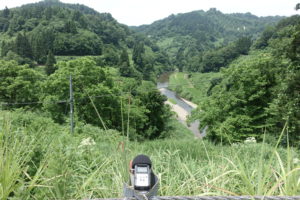
At that time, I thought since most people here travel by vehicle, it might be interesting to conduct a sound walk with the local residents.
In addition, it was also one of the aims of my residency to learn about the regional radio broadcasts. I had read in the book Farmers’ Horizon: Echigo-Tsumari Art Triennale, Urban x Rural, Japan x Hong Kong Connect an interview with the broadcaster Mr. Sato who worked at Tokamachi Radio Station, so I contacted him. During my own conversation with Mr. Sato, he shared with me many of his thoughts on sound, and promised to broadcast my work on his radio programme, which was very encouraging for me. Later, I accidentally found out that these local radio programmes were broadcast in the shopping arcades in Tokamachi during the day, which came as a surprise to me because radio programmes are rarely broadcast in public spaces in Hong Kong. While shopping arcades tend to be busy, there were not many people during the day, and it was very quiet walking down the street. When no vehicle was passing by one could distinctly hear the radio broadcast. What if the residents hear my or their own imitation sounds in the street? What happens when the sounds of the environment overlap with the sounds of people?
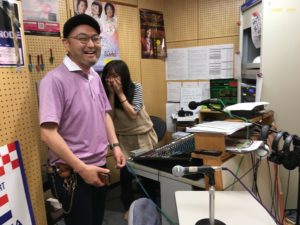
I was already back in Hong Kong when the work Sound Translator was broadcast in September this year, but I was able to listen to the live broadcast online. Before playing the work, Mr. Sato read an introduction to the work, and although I did not understand Japanese at all, I was both excited and nervous listening to the live broadcast, picturing myself delivering this sound work to everyone.
About “People”
Since I had to conduct basic interviews with the local people during the residency, I had the opportunity to visit a number of families. In addition to farming, these local people also managed some family businesses. I believe it was due to the impact of the festival and the enthusiasm of the local people that I received so much assistance and care. Even given the language barrier, we could communicate through translation applications on our mobile devices or by handwriting. And from people’s household objects and their configurations I could discern their various histories, habits, and cultures. They would share with me all kinds of things and invite me to take part in their daily activities. I felt that their attitude towards life was as simple and natural as the environment of this place.

I accompanied an old lady from a Japanese restaurant in her car, to visit various offices collecting used lunch boxes. She also had a pack of candies in her car for people who were working outdoors and needed the sugar. I also visited a very cute mother, whose Japanese-style wooden house was fantastically decorated, and who collected a lot of interesting toys and beautiful Japanese paper. There was a big world atlas inside her bathroom, with coloured pins on it representing the places visited by her three children. I later learned that there are often world atlases or multiplication tables in Japanese bathrooms, so parents can study with their children while they take baths together.
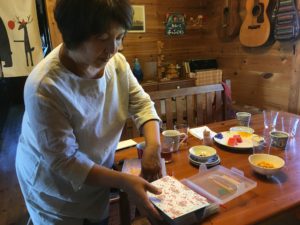
I came upon a barbecue party of some residents and mowed the grass with them afterwards. Another day at noon, I had a barbecue at home with some friendly mothers, while the children played with insects outside. A meticulously decorated house was occupied by a couple where the husband was a folk artist who had made over a hundred works in ten years. He designed and made many of the things in their house, though he humbly denied being an artist, saying that it was a hobby and he did it for his leisure. I also became acquainted with the owner of a century-old sushi restaurant who was very good at throwing a boomerang and made them from different materials.

I paid a visit to an old man who very much enjoyed his life; when he was younger, he built a treehouse in his backyard with his wife and friends. He liked jazz, and it was enchanting to look at the woods from inside the treehouse, surrounded by the songs of cicadas and jazz music. I joined a young mother and her daughter in a taiko class in preparation for the summer festival. There were many more kind and interesting people whom I was very lucky to meet. Their kindness and selfless sharing enriched my entire stay.
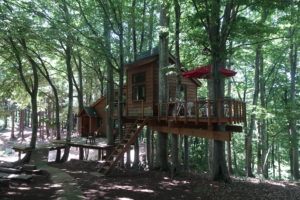
Postscript
During the interviews, I asked the local people what their favourite sound of this place was. They would usually imitate the sounds of the wind, birds, and animals etc. I myself prefer the sound of water. But thinking back now, my answer is actually the sound of laughter. What I like most is their laughter after imitating different sounds.
It was sound that connected us all. Thank you everyone for your voice.
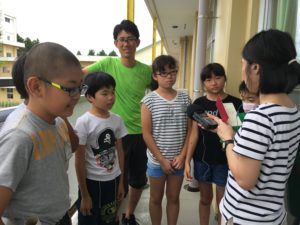
記大地藝術祭
在2018年的夏天,是我首次參加越後妻有大地藝術祭,也是第一次參與藝術家註留計劃。這次計劃,我期望從「人」出發去了解這個地方:除了聲音的部分,我從遇到的每個人身上也發現很多有趣的事情。
關於「聲音」
我在越後妻有主要居住在津南。如果不懂駕駛,又想到其他地方,如十日町市,就只可乘坐班次很少的火車或巴士 。因此當地人一般都以汽車代步,甚少會用半小時走路到一個地方。因為我不會駕駛,津南也沒有出租單車,所以只能經常以步行的方式到附近的地方。
我特別喜歡一段由我住的地方步行約20分鐘到火車站的一段路程。頭兩星期我所住的宿舍附近有不少農田,當時正值夏天,沿路走很容易便會看見民居附近一大片綠色的米田。路旁總會有一些「小河流」,「小河流」會沿著不同的分岔口再通往不同人家的田。一直走都會聽到「小河流」微弱的流水聲,有時經過較大的分岔口,聲音會特別澎湃; 一路走,水流經過不同深度或闊度的通道時,聲音再透過一些石屎渠蓋又會變得不一樣。早晨時份,能夠清晰地聽到幾種雀鳥會躲在樹上叫。經過民居,有時聽到他們在澆水、在看電視。一直在遠處的傳來的水聲,其實是「信濃川」的聲音。快將走到街口時,「信濃川」的聲音漸大,澎湃的流水聲像是告訴我快要到達火車站;臨近火車站,有時會聽到急促的腳步聲,中學生要趕上這班火車,錯過了便要一小時後才有下一班車。

我當時在想,這裡的人多數是用汽車代步,如果能跟當地居民在這邊進行一次聲音漫步,應該挺有意思的。
另外,了解地區電台也是一個我這次駐留的目的之一 。早前在《農人の野望》一書讀到一位在十日町電台工作的播音員佐藤先生的訪問。於是這次特意聯絡他見面,對話間佐藤先生分享了很多他對於聲音的想法,還答應讓我這次的作品在他的節目播放,對我有很大鼓勵。後來無意間發現這個地區電台節目平日會在十日町市內的商店街上廣播,這點讓我覺得很驚喜,因為在香港很少會在公共空間播放電台節目。商店街應該是比較繁忙的,但其實白天時也沒有幾個人,走在街上會覺得很靜;沒有車輛的聲音時,可以清晰地聽到電台節目的廣播。如果居民在街上聽到自己或當地人模仿的聲音時,會是怎樣的呢?環境的聲音和人們的聲音重疊時又會怎樣呢?

直到今年九月正式播放這個作品「聲音翻譯員」時,我雖已身在香港,但也可以於網上收聽直播。佐藤先生在播放作品前把作品簡介讀出,我雖然完全聽不懂日文,當時聽著這日本電台節目直播,心情既興奮又緊張,想像這段聲音作品終於能送給大家。
關於「人」
因為這次駐留期間需要與當地人進行簡單訪問,而令我有機會拜訪一些家庭。當地人除了以農務為主,也有不同家庭式經營的店鋪。相信因為大地藝術祭的力量,加上當地人的熱情,我得到很多人的協助和照顧,縱使語言不通,但能透過智能電話的翻譯功能或手寫等方法溝通,而且也能夠從每個人家中的物件、佈置,發現每人的歷史、生活習慣、文化等。她們會分享各種大小事情,又會邀請我參與她們的日常活動。我覺得她們的生活態度就如這個地方的環境一樣,簡樸自然。

我試過隨著日式料理餐廳的老婆婆駕車到附近不同公司收回飯盒,她會預備一包糖果在車上,派發給正在戶外工作的人補充糖分。拜訪過一個很可愛的媽媽的家,日式木屋內佈置充滿童真,又收藏了很多有趣的玩具和漂亮的日式和紙。她家的洗手間內貼有一張世界地圖,上面釘了不同顏色的大頭釘,原來代表她的三個兒女去過的地方。後來得知,日本家庭的浴室通常會擺放世界地圖或乘數表等,因為爸爸媽媽和孩子一起洗澡時可以看著這些圖表一起學習。

我又試過遇到當地一些居民的燒烤聚會,聚會後便會一起割草;試過和一班友善的媽媽們中午在家中燒烤,孩子們在大自然與小昆蟲耍樂; 看到一對夫婦的家周圍充滿心思的佈置,原來丈夫是一位民間藝術家,十年內做過過百件作品,家中有很多東西都是由他設計和製作,但他謙虛的說自己不是藝術家,創作是興趣,只要想到便會做; 又認識到百年壽司店的老闆,他同時是一位迴力鏢好手,會自己用不同物料製作迴力鏢。

我也拜訪過一位很會享受生活的伯伯,年輕時與太太和朋友們一同在家的後園興建樹屋,他很喜歡聽爵士樂,在樹屋內看著一片樹林再被周圍的蟬聲和爵士樂包圍著的時候,實在是令人沉醉不已;又試過和年輕媽媽和她的女兒一起上太鼓班為夏祭表演作準備;還有很多很善良和有趣的人,十分幸運認識到她們,因為她們的親切和無私的分享,豐富了我整趟旅程。

後記
我在訪問時問當地人最喜歡這個地方的聲音是甚麼,他們一般會模仿風聲、鳥聲、動物聲等,我則喜歡這裡的水聲。但回想起來最深刻的答案是——笑聲。原來,我最喜歡的也是他們模仿不同的聲音後的笑聲。
這次是聲音把我們連繫起來,謝謝你們每一把聲音。
